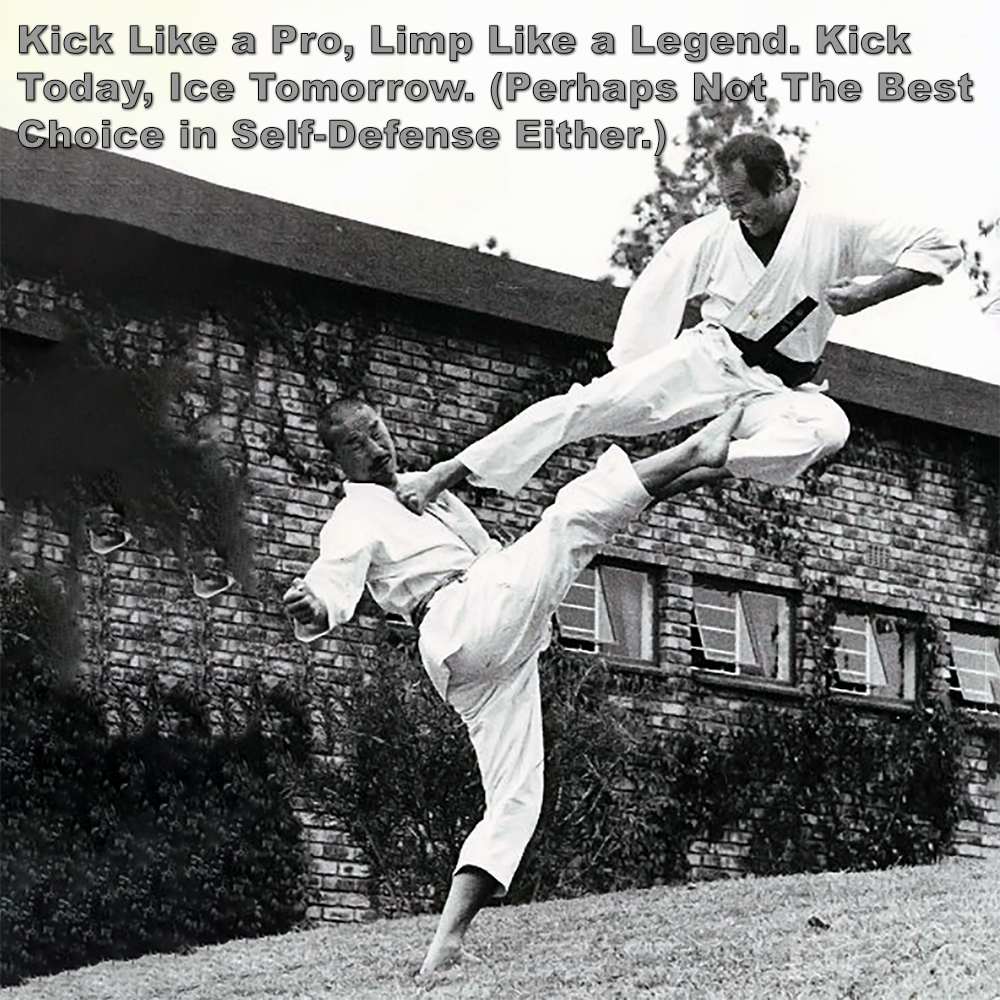
(Approx 2 minute 40 second read)
For the last few days, I’ve been dealing with an annoying hip flexor strain. I have no idea how I got it – perhaps I slept the wrong way. I seem to be at that age.
.
Once again, it sparked an image in my mind of having to defend myself while injured. Believe me, the pain associated with this strain is significant. It restricts my movements, including just standing up from a seated position and walking. Kicking? Well, forget it.
.
Today, kicking is a major part of training. This is primarily because it’s effective in the competitive environment. Some competitors are amazing athletes who can apply kicks in ways that would be totally inappropriate for those who are not as physically gifted.
.
When I was competing in the 1970s and 1980s, I used kicks extremely effectively. And when I’m not limping along, I’m still able to comfortably and quickly kick to head height, often to the surprise of my students.
.
However, if you compare the techniques of modern karate with those recorded within kata, you’ll notice that kicks are nowhere near as widely used. The simple reason for this is that the techniques in kata were designed for a different context and environment, so they are not emphasized in the same way.
.
Using kicks in self-defense may not be a wise decision. This is because your motion and stability are severely compromised the instant you take a foot off the floor. In many real-world situations, being grabbed, pulled, or pushed could be commonplace, so you rarely get the space to use kicks. That’s not to say that kicking doesn’t have a role to play, because it does. But as with everything, context is crucial.
.
The environment could be a problem too – weather, the type of footwear you’re wearing, whether your clothing restricts movement. Training too heavily in kicking for self-defense, when these factors may compromise its use, could be misguided. Time might be better spent training techniques that can be relied on in any situation, where your responses become automatic, instinctive, and appropriate to the moment.
.
If you look at old photos of Okinawan people, you’ll notice the wooden ‘geta’ sandals they often wore – perhaps another reason kicking is not emphasized in kata. Depending on whether your karate style is modern or an Okinawan style, most kata feature low-level kicks, in addition to implied kicks with stepping. These kicks work in conjunction with hand movements to form the technique. Kicks may be delivered before or after the hands; either way, they’re used to bring the opponent into the strike, lock, or throw through ‘kuzushi’ (unbalancing/destabilizing).
.
The feet can be used to set up the hands, and the hands can be used to set up foot attacks. The legs can also be used to jam the opponent’s movement, preventing them from kicking or moving properly.
.
Self-defense is about doing what works, and what works may not always be the most athletic technique. With my current hip flexor strain, I’m reminded that as we age or deal with injuries, our approach must adapt. While kicks are useful in certain situations, you have to be careful with how and when you use them. Context is key, and understanding how to utilize kicks within your own capabilities, the environment, and the moment is essential.
.
Of course, there are individuals who are supreme at kicking and wouldn’t hesitate to use them, no matter the context. But for mere mortals – and old blokes like me struggling to move after a sleep injury – kicking may not be the ideal choice.
.
Sometimes, like now for me, you’re injured, and some techniques give way to basic, efficient movement. The real challenge is being able to defend yourself effectively, no matter the situation. So, sleep well – injured while sleeping isn’t a great excuse! 😉
.
.
Written by Adam Carter – Shuri Dojo.
.
.
Photo Credit: Masahiko Tanaka (left) with Sensei Stan Schmidt
